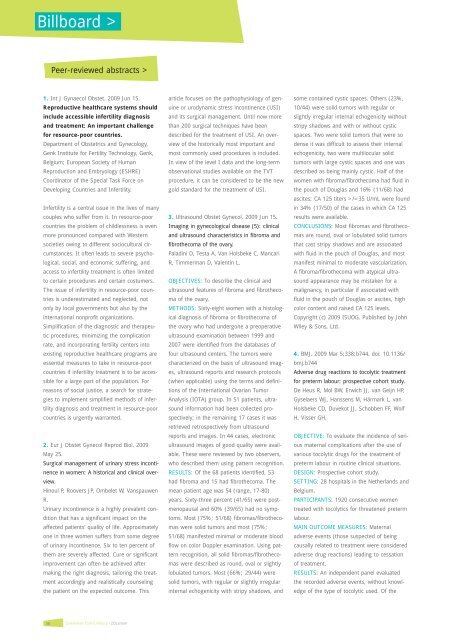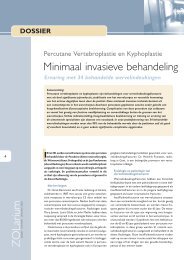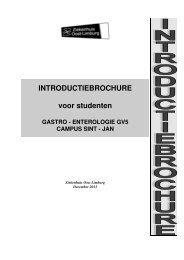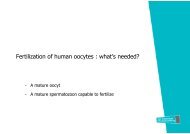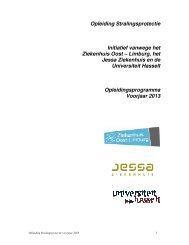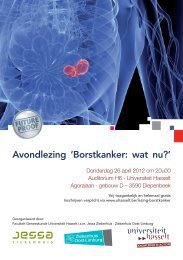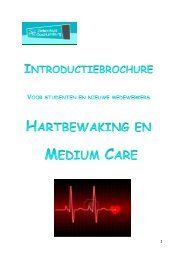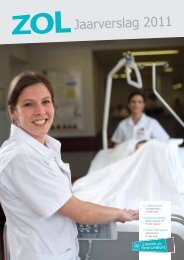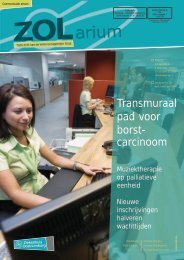Epiduroscopie - Ziekenhuis Oost-Limburg
Epiduroscopie - Ziekenhuis Oost-Limburg
Epiduroscopie - Ziekenhuis Oost-Limburg
Create successful ePaper yourself
Turn your PDF publications into a flip-book with our unique Google optimized e-Paper software.
Billboard ><br />
Peer-reviewed abstracts ><br />
1. Int J Gynaecol Obstet. 2009 Jun 15.<br />
Reproductive healthcare systems should<br />
include accessible infertility diagnosis<br />
and treatment: An important challenge<br />
for resource-poor countries.<br />
Department of Obstetrics and Gynecology,<br />
Genk Institute for Fertility Technology, Genk,<br />
Belgium; European Society of Human<br />
Reproduction and Embryology (ESHRE)<br />
Coordinator of the Special Task Force on<br />
Developing Countries and Infertility.<br />
Infertility is a central issue in the lives of many<br />
couples who suffer from it. In resource-poor<br />
countries the problem of childlessness is even<br />
more pronounced compared with Western<br />
societies owing to different sociocultural circumstances.<br />
It often leads to severe psychological,<br />
social, and economic suffering, and<br />
access to infertility treatment is often limited<br />
to certain procedures and certain costumers.<br />
The issue of infertility in resource-poor countries<br />
is underestimated and neglected, not<br />
only by local governments but also by the<br />
international nonprofit organizations.<br />
Simplification of the diagnostic and therapeutic<br />
procedures, minimizing the complication<br />
rate, and incorporating fertility centers into<br />
existing reproductive healthcare programs are<br />
essential measures to take in resource-poor<br />
countries if infertility treatment is to be accessible<br />
for a large part of the population. For<br />
reasons of social justice, a search for strategies<br />
to implement simplified methods of infertility<br />
diagnosis and treatment in resource-poor<br />
countries is urgently warranted.<br />
2. Eur J Obstet Gynecol Reprod Biol. 2009<br />
May 25.<br />
Surgical management of urinary stress incontinence<br />
in women: A historical and clinical overview.<br />
Hinoul P, Roovers JP, Ombelet W, Vanspauwen<br />
R.<br />
Urinary incontinence is a highly prevalent condition<br />
that has a significant impact on the<br />
affected patients’ quality of life. Approximately<br />
one in three women suffers from some degree<br />
of urinary incontinence. Six to ten percent of<br />
them are severely affected. Cure or significant<br />
improvement can often be achieved after<br />
making the right diagnosis, tailoring the treatment<br />
accordingly and realistically counseling<br />
the patient on the expected outcome. This<br />
36 <strong>Ziekenhuis</strong> <strong>Oost</strong>-<strong>Limburg</strong> I ZOLarium<br />
article focuses on the pathophysiology of genuine<br />
or urodynamic stress incontinence (USI)<br />
and its surgical management. Until now more<br />
than 200 surgical techniques have been<br />
described for the treatment of USI. An overview<br />
of the historically most important and<br />
most commonly used procedures is included.<br />
In view of the level I data and the long-term<br />
observational studies available on the TVT<br />
procedure, it can be considered to be the new<br />
gold standard for the treatment of USI.<br />
3. Ultrasound Obstet Gynecol. 2009 Jun 15.<br />
Imaging in gynecological disease (5): clinical<br />
and ultrasound characteristics in fibroma and<br />
fibrothecoma of the ovary.<br />
Paladini D, Testa A, Van Holsbeke C, Mancari<br />
R, Timmerman D, Valentin L.<br />
OBJECTIVES: To describe the clinical and<br />
ultrasound features of fibroma and fibrothecoma<br />
of the ovary.<br />
METHODS: Sixty-eight women with a histological<br />
diagnosis of fibroma or fibrothecoma of<br />
the ovary who had undergone a preoperative<br />
ultrasound examination between 1999 and<br />
2007 were identified from the databases of<br />
four ultrasound centers. The tumors were<br />
characterized on the basis of ultrasound images,<br />
ultrasound reports and research protocols<br />
(when applicable) using the terms and definitions<br />
of the International Ovarian Tumor<br />
Analysis (IOTA) group. In 51 patients, ultrasound<br />
information had been collected prospectively;<br />
in the remaining 17 cases it was<br />
retrieved retrospectively from ultrasound<br />
reports and images. In 44 cases, electronic<br />
ultrasound images of good quality were available.<br />
These were reviewed by two observers,<br />
who described them using pattern recognition.<br />
RESULTS: Of the 68 patients identified, 53<br />
had fibroma and 15 had fibrothecoma. The<br />
mean patient age was 54 (range, 17-80)<br />
years. Sixty-three percent (41/65) were postmenopausal<br />
and 60% (39/65) had no symptoms.<br />
Most (75%; 51/68) fibromas/fibrothecomas<br />
were solid tumors and most (75%;<br />
51/68) manifested minimal or moderate blood<br />
flow on color Doppler examination. Using pattern<br />
recognition, all solid fibromas/fibrothecomas<br />
were described as round, oval or slightly<br />
lobulated tumors. Most (66%; 29/44) were<br />
solid tumors, with regular or slightly irregular<br />
internal echogenicity with stripy shadows, and<br />
some contained cystic spaces. Others (23%,<br />
10/44) were solid tumors with regular or<br />
slightly irregular internal echogenicity without<br />
stripy shadows and with or without cystic<br />
spaces. Two were solid tumors that were so<br />
dense it was difficult to assess their internal<br />
echogenicity, two were multilocular solid<br />
tumors with large cystic spaces and one was<br />
described as being mainly cystic. Half of the<br />
women with fibroma/fibrothecoma had fluid in<br />
the pouch of Douglas and 16% (11/68) had<br />
ascites; CA 125 titers >/=35 U/mL were found<br />
in 34% (17/50) of the cases in which CA 125<br />
results were available.<br />
CONCLUSIONS: Most fibromas and fibrothecomas<br />
are round, oval or lobulated solid tumors<br />
that cast stripy shadows and are associated<br />
with fluid in the pouch of Douglas, and most<br />
manifest minimal to moderate vascularization.<br />
A fibroma/fibrothecoma with atypical ultrasound<br />
appearance may be mistaken for a<br />
malignancy, in particular if associated with<br />
fluid in the pouch of Douglas or ascites, high<br />
color content and raised CA 125 levels.<br />
Copyright (c) 2009 ISUOG. Published by John<br />
Wiley & Sons, Ltd.<br />
4. BMJ. 2009 Mar 5;338:b744. doi: 10.1136/<br />
bmj.b744<br />
Adverse drug reactions to tocolytic treatment<br />
for preterm labour: prospective cohort study.<br />
De Heus R, Mol BW, Erwich JJ, van Geijn HP,<br />
Gyselaers WJ, Hanssens M, Härmark L, van<br />
Holsbeke CD, Duvekot JJ, Schobben FF, Wolf<br />
H, Visser GH.<br />
OBJECTIVE: To evaluate the incidence of seri-<br />
ous maternal complications after the use of<br />
various tocolytic drugs for the treatment of<br />
preterm labour in routine clinical situations.<br />
DESIGN: Prospective cohort study.<br />
SETTING: 28 hospitals in the Netherlands and<br />
Belgium.<br />
PARTICIPANTS: 1920 consecutive women<br />
treated with tocolytics for threatened preterm<br />
labour.<br />
MAIN OUTCOME MEASURES: Maternal<br />
adverse events (those suspected of being<br />
causally related to treatment were considered<br />
adverse drug reactions) leading to cessation<br />
of treatment.<br />
RESULTS: An independent panel evaluated<br />
the recorded adverse events, without knowledge<br />
of the type of tocolytic used. Of the


